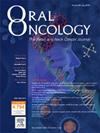Induction chemotherapy and concurrent chemoradiotherapy with cisplatin for T4 nasoethmoidal squamous cell carcinoma: The value of paclitaxel, carboplatin and cetuximab (PCE)
IF 4
2区 医学
Q1 DENTISTRY, ORAL SURGERY & MEDICINE
引用次数: 0
Abstract
Background
Locally advanced nasoethmoidal squamous cell carcinoma (SCC) is rare and often unsuitable for surgical resection. Data on the potential clinical benefits of combining induction chemotherapy (IC) and sequential definitive chemoradiotherapy for this condition is limited.
Methods
We retrospectively investigated T4 nasoethmoidal SCC patients who underwent proton or photon chemoradiotherapy with curative intent at the National Cancer Center Hospital East between April 2014 and May 2022. Patients were categorized into three groups based on IC regimen: no IC (No-IC), paclitaxel plus carboplatin plus cetuximab (IC-PCE), and docetaxel plus cisplatin plus S-1 (IC-TPS).
Results
Twenty-five patients were analyzed (No IC, 9; IC-PCE, 10; and IC-TPS, 6). The IC-PCE group had the highest ratio of Stage IVB to IVA patients. IC-PCE and IC-TPS yielded objective responses in eight (80 %) and two (33 %) patients, respectively. All subjects completed radiotherapy, with the median relative to dose intensity of concurrent cisplatin reaching 100 % in all groups. Complete responses were observed in 22 patients. Three patients in the No IC or IC-TPS group showed a partial response after the completion of planned treatment. On a median follow-up of 42 months, the 3-year recurrence-free survival (RFS) rate was 90.0 % in the IC-PCE group and 33.3 % in the remaining groups. Of note, the IC-PCE group had significantly better RFS (log-rank p-value; 0.023) despite no differences in overall survival, time-to-locoregional progression, or time-to-distant metastasis.
Conclusion
Sequential IC-PCE followed by concurrent chemoradiotherapy with cisplatin appears promising as an effective therapeutic strategy for T4 nasoethmoidal SCC.
诱导化疗与顺铂同步放化疗治疗T4鼻筛鳞状细胞癌:紫杉醇、卡铂和西妥昔单抗(PCE)的价值
背景:局部进展期鼻筛鳞状细胞癌(SCC)是罕见的,通常不适合手术切除。对于这种情况,联合诱导化疗(IC)和序贯明确放化疗的潜在临床益处的数据有限。方法回顾性分析2014年4月至2022年5月在国立肿瘤中心东医院接受质子或光子放化疗的T4型鼻筛鳞状细胞癌患者。根据IC方案将患者分为三组:无IC (no -IC)、紫杉醇加卡铂加西妥昔单抗(IC- pce)和多西紫杉醇加顺铂加S-1 (IC- tps)。结果共分析25例患者(No . IC, 9;IC-PCE 10;IC-TPS, 6)。IC-PCE组IVB期与IVA期患者比例最高。IC-PCE和IC-TPS分别在8例(80%)和2例(33%)患者中产生客观反应。所有受试者均完成放疗,所有组中顺铂相对剂量强度的中位数达到100%。22例患者观察到完全缓解。No IC或IC- tps组中有3例患者在完成计划治疗后出现部分缓解。在42个月的中位随访中,IC-PCE组的3年无复发生存率(RFS)为90.0%,其余组为33.3%。值得注意的是,IC-PCE组的RFS (log-rank p-value;0.023),尽管在总生存期、局部进展时间或远处转移时间方面没有差异。结论序贯IC-PCE联合顺铂放化疗是T4鼻筛细胞癌的有效治疗策略。
本文章由计算机程序翻译,如有差异,请以英文原文为准。
求助全文
约1分钟内获得全文
求助全文
来源期刊

Oral oncology
医学-牙科与口腔外科
CiteScore
8.70
自引率
10.40%
发文量
505
审稿时长
20 days
期刊介绍:
Oral Oncology is an international interdisciplinary journal which publishes high quality original research, clinical trials and review articles, editorials, and commentaries relating to the etiopathogenesis, epidemiology, prevention, clinical features, diagnosis, treatment and management of patients with neoplasms in the head and neck.
Oral Oncology is of interest to head and neck surgeons, radiation and medical oncologists, maxillo-facial surgeons, oto-rhino-laryngologists, plastic surgeons, pathologists, scientists, oral medical specialists, special care dentists, dental care professionals, general dental practitioners, public health physicians, palliative care physicians, nurses, radiologists, radiographers, dieticians, occupational therapists, speech and language therapists, nutritionists, clinical and health psychologists and counselors, professionals in end of life care, as well as others interested in these fields.
 求助内容:
求助内容: 应助结果提醒方式:
应助结果提醒方式:


